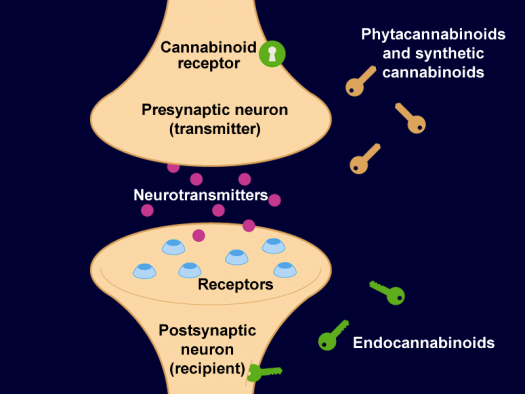endocannabinoid-system-receptors.png

Illustration by fundación canna; adapted and translated by FAIM / CC BY-SA 4.0 via Wikimedia Commons
The use of cannabis has many applications including cancer, pain, neurological conditions, psychological issues, traumatic brain injury, to mention a few. The endocannabinoid system was discovered about 20 years ago. It influences many functions in the body and releases several cannabinoid substances naturally. This is one reason runners experience a “runners high,” for example.
Participants at a workshop led by Dr. Joseph Maroon at the American Academy of Anti-Aging Medicine (A4M) conference in December 2018 learned more about using marijuana to help address the opioid crisis, indications for marijuana and how it works, and the basic principles regarding the phytocannabinoids including CBD and THC.
Scientists have found that plants make phytocannabinoids which respond in the body in a similar fashion to endocannabinoids. THC mimics the endocannabinoid called anandamide. Cannabidiol (CBD) mimics the endocannabinoid called 2-AG. Receptors for cannabinoids are found on the cell surface in various places in the body. Anandamide/THC receptors called CB1 are in the peripheral systems including the brain. 2-AG/CBD receptors are found throughout the body as well as on immune cells. CB1 receptors are only sparsely found in the cardiopulmonary center of the brain stem which explains why there are no reported deaths due to respiratory suppression with THC.
Marijuana and hemp supply sources of phytocannabinoids, including over 50 cannabinoids with many actions. The indications include intractable headaches, cancer pain, nerve pain, muscle spasms/spasticity, glaucoma, nausea from cancer chemotherapy, poor appetite and weight loss caused by chronic illness, such as HIV, Crohn’s disease, PTSD, and intractable seizures, etc. More specifically, historically the individual cannabinoids have been found to do the following: CBDA reduces inflammation and reduces cancer cell growth; CBG aids sleep, inhibits cancer cell growth, promotes bone growth, slows bacterial growth; CBGA slows bacterial growth, reduces inflammation, relieves pain; CBC inhibits cancer cell growth, promotes bone growth, reduces inflammation, relieves pain; CBCA reduces inflammation, addresses fungal infection; 9-THCA aids sleep, inhibits cancer cell growth, suppresses muscle spasms; 9-THC reduces vomiting and nausea, relieves pain, stimulates appetite, suppresses muscle spasms; 8-THC relieves pain; THCV reduces convulsions and seizures, promotes bone growth; and finally CBC is antibacterial, inhibits cancer cell growth, is neuro-protective, promotes bone growth, reduces seizures and convulsions, reduces blood sugar levels, reduces inflammation, reduces risk of artery blockage, reduces small intestine contractions, reduces vomiting and nausea, relieves pain, relieves anxiety, slows bacterial growth, suppresses muscle spasm, is tranquilizing, addresses psoriasis, and is a vasorelaxant.
Research shows the benefits of THC include increased appetite and weight gain, as well as increasing cancer cell death. It helps with nausea, spasticity and movement disorders. The safety concerns include limited human studies, dosing data and the psychoactive effect.
Research also shows the benefits of CBD include anti-inflammatory, anti-oxidant, neuroprotective, analgesic/anxiolytic, anti-seizure, blunts excessive immune response, apoptotic (cell death), and no psychotropic effects. Safety concerns include limited human studies and dosing data.
One of the very valuable applications of cannabinoids is in the fight against opioid addiction. Cannabinoids are proving to help those addicted, to regain their health. The opioid crisis is very real. There are between 55,000 and 60,000 medicinal overdoses annually and 66% of these are due to opioids. In the 1990s the medical community was told to limit pain at any cost so pain medications were prescribed liberally. This behavior continues. When the patient can no longer get opioids legally, they turn to heroin and fentanyl. Since 1999 deaths have quadrupled. In 2016, 115 people died every day from opioid overdoses in America. Cannabinoids can help reverse this trend. Medical marijuana can help addicts wean off opioids. Medical marijuana is legally accessible to 59.3% of the population in the United States.
For more information contact The American Academy of Anti-Aging Medicine.


